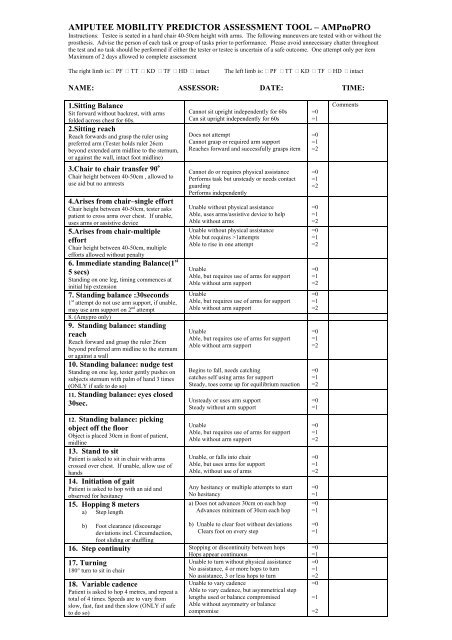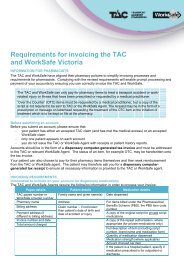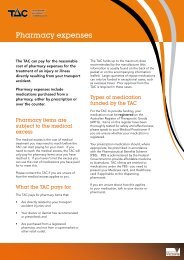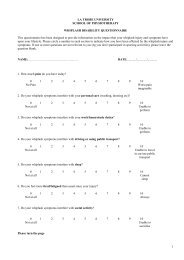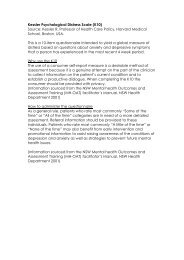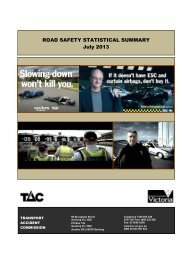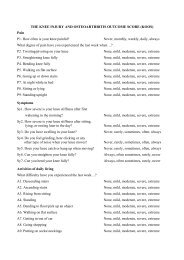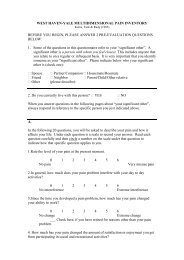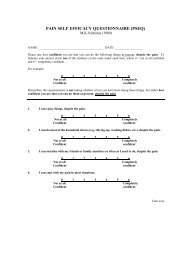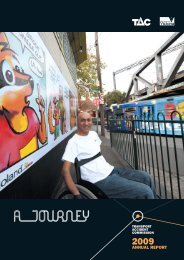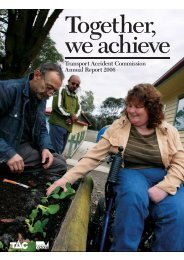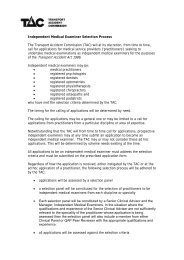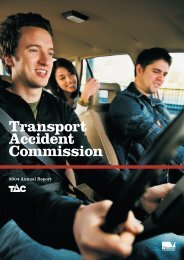AMPUTEE MOBILITY PREDICTOR ASSESSMENT TOOL ...
AMPUTEE MOBILITY PREDICTOR ASSESSMENT TOOL ...
AMPUTEE MOBILITY PREDICTOR ASSESSMENT TOOL ...
Create successful ePaper yourself
Turn your PDF publications into a flip-book with our unique Google optimized e-Paper software.
<strong>AMPUTEE</strong> <strong>MOBILITY</strong> <strong>PREDICTOR</strong> <strong>ASSESSMENT</strong> <strong>TOOL</strong> – AMPnoPRO<br />
Instructions: Testee is seated in a hard chair 40-50cm height with arms. The following maneuvers are tested with or without the<br />
prosthesis. Advise the person of each task or group of tasks prior to performance. Please avoid unnecessary chatter throughout<br />
the test and no task should be performed if either the tester or testee is uncertain of a safe outcome. One attempt only per item<br />
Maximum of 2 days allowed to complete assessment<br />
The right limb is: PF TT KD TF HD intact The left limb is: PF TT KD TF HD intact<br />
NAME: ASSESSOR: DATE: TIME:<br />
1.Sitting Balance<br />
Sit forward without backrest, with arms<br />
folded across chest for 60s.<br />
2.Sitting reach<br />
Reach forwards and grasp the ruler using<br />
preferred arm (Tester holds ruler 26cm<br />
beyond extended arm midline to the sternum,<br />
or against the wall, intact foot midline)<br />
3.Chair to chair transfer 90°<br />
Chair height between 40-50cm , allowed to<br />
use aid but no armrests<br />
4.Arises from chair–single effort<br />
Chair height between 40-50cm, tester asks<br />
patient to cross arms over chest. If unable,<br />
uses arms or assistive device<br />
5.Arises from chair-multiple<br />
effort<br />
Chair height between 40-50cm, multiple<br />
efforts allowed without penalty<br />
6. Immediate standing Balance(1 st<br />
5 secs)<br />
Standing on one leg, timing commences at<br />
initial hip extension<br />
7. Standing balance :30seconds<br />
1 st attempt do not use arm support, if unable,<br />
may use arm support on 2 nd attempt<br />
8. (Amypro only)<br />
9. Standing balance: standing<br />
reach<br />
Reach forward and grasp the ruler 26cm<br />
beyond preferred arm midline to the sternum<br />
or against a wall<br />
10. Standing balance: nudge test<br />
Standing on one leg, tester gently pushes on<br />
subjects sternum with palm of hand 3 times<br />
(ONLY if safe to do so)<br />
11. Standing balance: eyes closed<br />
30sec.<br />
12. Standing balance: picking<br />
object off the floor<br />
Object is placed 30cm in front of patient,<br />
midline<br />
13. Stand to sit<br />
Patient is asked to sit in chair with arms<br />
crossed over chest. If unable, allow use of<br />
hands<br />
14. Initiation of gait<br />
Patient is asked to hop with an aid and<br />
observed for hesitancy<br />
15. Hopping 8 meters<br />
a) Step length<br />
b) Foot clearance (discourage<br />
deviations incl. Circumduction,<br />
foot sliding or shuffling<br />
Cannot sit upright independently for 60s<br />
Can sit upright independently for 60s<br />
Does not attempt<br />
Cannot grasp or required arm support<br />
Reaches forward and successfully grasps item<br />
Cannot do or requires physical assistance<br />
Performs task but unsteady or needs contact<br />
guarding<br />
Performs independently<br />
Unable without physical assistance<br />
Able, uses arms/assistive device to help<br />
Able without arms<br />
Unable without physical assistance<br />
Able but requires >1attempts<br />
Able to rise in one attempt<br />
Unable<br />
Able, but requires use of arms for support<br />
Able without arm support<br />
Unable<br />
Able, but requires use of arms for support<br />
Able without arm support<br />
Unable<br />
Able, but requires use of arms for support<br />
Able without arm support<br />
Begins to fall, needs catching<br />
catches self using arms for support<br />
Steady, toes come up for equilibrium reaction<br />
Unsteady or uses arm support<br />
Steady without arm support<br />
Unable<br />
Able, but requires use of arms for support<br />
Able without arm support<br />
Unable, or falls into chair<br />
Able, but uses arms for support<br />
Able, without use of arms<br />
Any hesitancy or multiple attempts to start<br />
No hesitancy<br />
a) Does not advances 30cm on each hop<br />
Advances minimum of 30cm each hop<br />
b) Unable to clear foot without deviations<br />
Clears foot on every step<br />
16. Step continuity Stopping or discontinuity between hops<br />
17. Turning<br />
180° turn to sit in chair<br />
18. Variable cadence<br />
Patient is asked to hop 4 metres, and repeat a<br />
total of 4 times. Speeds are to vary from<br />
slow, fast, fast and then slow (ONLY if safe<br />
to do so)<br />
Hops appear continuous<br />
Unable to turn without physical assistance<br />
No assistance, 4 or more hops to turn<br />
No assistance, 3 or less hops to turn<br />
Unable to vary cadence<br />
Able to vary cadence, but asymmetrical step<br />
lengths used or balance compromised<br />
Able without asymmetry or balance<br />
compromise<br />
=0<br />
=1<br />
=0<br />
=1<br />
=2<br />
=0<br />
=1<br />
=2<br />
=0<br />
=1<br />
=2<br />
=0<br />
=1<br />
=2<br />
=0<br />
=1<br />
=2<br />
=0<br />
=1<br />
=2<br />
=0<br />
=1<br />
=2<br />
=0<br />
=1<br />
=2<br />
=0<br />
=1<br />
=0<br />
=1<br />
=2<br />
=0<br />
=1<br />
=2<br />
=0<br />
=1<br />
=0<br />
=1<br />
=0<br />
=1<br />
=0<br />
=1<br />
=0<br />
=1<br />
=2<br />
=0<br />
=1<br />
=2<br />
Comments
19. Hopping over an obstacle<br />
The patient is asked to hop over an obstacle<br />
10cm high<br />
Unable<br />
Able, but catches foot or appears unsafe<br />
Able, safe and independant<br />
=0<br />
=1<br />
=2<br />
20. Stairs<br />
Patient is asked to ascend and descend at least<br />
2 steps without holding the rail using<br />
crutches. If unable, patient may use the rail.<br />
Ascending; Unable<br />
Able using the rail<br />
Able without the rail<br />
Descending; Unable<br />
Able using the rail<br />
Able without the rail<br />
=0<br />
=1<br />
=2<br />
=0<br />
=1<br />
=2<br />
21. Assistive device selection Bed bound<br />
Wheelchair<br />
Frame<br />
Crutches<br />
=0<br />
=1<br />
=2<br />
=3<br />
Score ___/39<br />
K Classification AMPnoPRO score Key AMP Tasks<br />
K0 ? Items 1,2,3,4,5,6,7<br />
• Ability to sit or stand without difficulty<br />
K1 ? Items 4,6,7,9,10,13,14<br />
• Able to sit to stand<br />
• Moderate standing balance<br />
• Can’t displace COM over BOS<br />
• Initiates gait, possibly hesitant<br />
• Uses an assistive device<br />
• Probably low endurance<br />
K2 ? Items 7,9,10,15,16,17<br />
• Able to maintain standing balance<br />
• Ability for limited displacement of COM over BOS<br />
• Able to maintain balance with assistance when nudged<br />
• Able to take a full stride with at least one foot<br />
• Maintains step continuity and can complete a 3 step<br />
turn without intervention<br />
K3 ? Items 9,10,12,15,16,17,19,20<br />
• Ability to maintain single limb balance<br />
• Able to displace COM without difficulty<br />
• Able to maintain balance without assistance when<br />
nudged<br />
• Able to alter COM and correct without difficulty<br />
• Gait demonstrates equal strides, good continuity,<br />
varied cadence<br />
• Ability to turn independently with less than 3 steps<br />
• Able to step over obstacles and climb stairs<br />
K4 ? Items 9,15,16,17,18,19,20<br />
• Ability to maintain single limb balance with both legs<br />
• Able to perform most tasks at the highest level with<br />
good balance<br />
• Gait is symmetrical with the ability to clearly vary<br />
cadence and negotiate turns, obstacles and stairs<br />
independently


